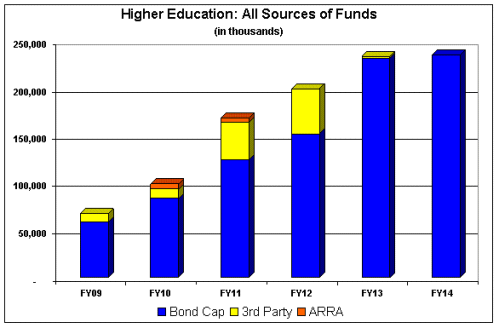Quick Links
- Report
- Introduction
- Accomplishments & Initiatives
- American Recovery and Reinvestment Act of 2009
- Development of the FY10-14 Capital Investment Plan
- Affordability & Fiscal Responsibility
- Aggregate FY10-14 Capital Investment Plan
- Capital Investments by Investment Category
- Appendix A - Debt Affordability Analysis
- Appendix B - Bond Bills
- Appendix C - Project Listing (xls)
- Appendix D - Project Descriptions (pdf)
- Plan by Investment
- Plan by Capital Agency
- Plan by Beneficiary Agency
- Downloads
- Site Map
Higher Education
The Commonwealth’s higher education system, which serves approximately 260,000 students, is comprised of 29 campuses divided into three segments: 15 community colleges, nine state colleges and five University campuses. In response to the alarming capital deficiencies at many of these institutions, Governor Patrick dramatically increased planned spending for higher education capital projects in the first five-year capital plan in fiscal year 2008, and he obtained passage of a $2.2 billion, 10-year higher education bond bill in 2008 as a key component of his 10-year education reform initiative.
The following graph reflects the Administration’s capital commitment to public higher education over the next five years as compared to projected fiscal 2009 capital spending for higher education. The state’s capital investment in higher education will increase each year, and by 2013, higher education investments will represent 12% of the total bond-cap funded capital budget, compared to just 3% in fiscal year 2007. Total estimated bond-funded spending over the five-year period is $826 million, ramping up over the course of five years as construction projects get underway to an annual investment of over $235 million by FY14.
This significant capital investment in higher education is exclusive of additional amounts that will be invested in public higher education facilities as a part of the Life Sciences Initiative capital program included in the Economic Development investment category described above. In addition, while the chart below reflects amounts the University and college campuses are contributing to projects being carried out and primarily funded by the Commonwealth and reflects ARRA funding that the Commonwealth is investing in higher education campuses, it does not reflect additional amounts of campus funding and ARRA funding received directly by the campuses that the campuses invest in capital projects that they carry out.

Fiscal year 2010 capital investments in higher education will support the objectives and areas of strategic focus of our public colleges and universities. Highlights of the fiscal year 2010 capital plan for higher education include:
Continue or complete construction projects at three state or community colleges and three at different University of Massachusetts campuses.
Start construction for major projects at Bridgewater State College, Massachusetts Maritime Academy, North Shore Community College and Greenfield Community College.
Commence studies or design for major new projects at ten sites, including Holyoke Community College, Mass College of Liberal Arts, Fitchburg State College, Salem State College, Qunsigamond Community College and Bristol Community College as well as at University of Massachusetts Boston, Dartmouth, Amherst and Lowell campuses.
ARRA Funding
The majority of ARRA capital funds for higher education will be awarded directly to the institutions. Of the $55 million awarded to the Commonwealth through the State Energy Program, the Commonwealth is allocating $10 million of such amount for renewable energy and energy efficiency investments at higher education campuses. The Commonwealth expects to expend $5 million of this ARRA funding on such investments in FY10.
 top of page
top of page